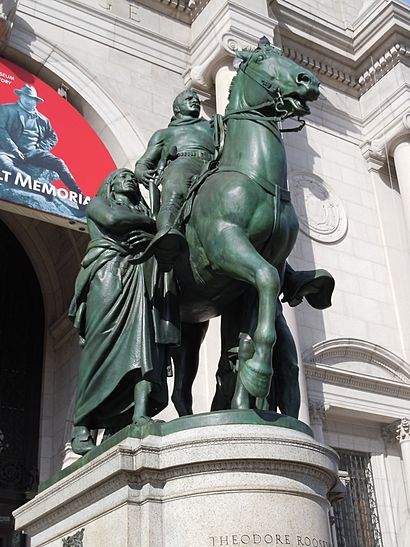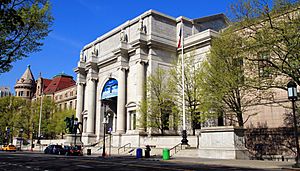Equestrian Statue of Theodore Roosevelt (New York City) facts for kids
Quick facts for kids Equestrian Statue of Theodore Roosevelt |
|
|---|---|
 |
|
| Artist | James Earle Fraser |
| Year | 1939 |
| Type | Bronze |
| Dimensions | 300 cm × 218 cm × 450 cm (10 ft × 7 ft 2 in × 14 ft 9 in) |
| Location | Manhattan, United States |
| 40°46′51.01″N 73°58′22.21″W / 40.7808361°N 73.9728361°W | |
The Equestrian Statue of Theodore Roosevelt is a large bronze sculpture created in 1939 by James Earle Fraser. It stands on public land next to the American Museum of Natural History in New York City. The statue shows Theodore Roosevelt, who was a former U.S. President, riding a horse. Two men are walking beside him: one is an indigenous person and the other is an African man.
On June 21, 2020, the Museum announced that it wanted to remove the statue. The Museum's president, Ellen V. Futter, explained that the decision was not about judging Roosevelt himself. Instead, it was because the statue's "hierarchical composition" showed people in a way that suggested some were more important than others. New York City Mayor Bill de Blasio supported the removal, as did Roosevelt's great-grandson, Theodore Roosevelt IV, and great-great-grandson Kermit Roosevelt III.
Contents
About the Statue's History
This statue was officially revealed on October 27, 1940. It was made by the Gorham Manufacturing Company in Providence, Rhode Island.
The words carved into the statue's base tell us more about it:
- On the back: J E FRASER SC 1939 (This means James Earle Fraser sculpted it in 1939).
- On the front: THEODORE ROOSEVELT 1858–1919 (This shows who the statue is of and his birth and death years).
- On the left side: GOVERNOR OF THE STATE OF NEW YORK 1899 1901 (Roosevelt was New York's governor).
- On the right side: PRESIDENT OF THE UNITED STATES 1901 1909 (Roosevelt was also a U.S. President).
Why the Statue Was Made
The Theodore Roosevelt Association asked James Earle Fraser to create this sculpture in the 1930s. Fraser had also designed other important statues.
The statue was placed at the entrance to a special hall in the Museum. This hall features dioramas (3D scenes) about Carl Akeley. Akeley had traveled with Roosevelt on an expedition to Africa. The statue and its base were designed to fit perfectly with the Museum's grand, classical architecture.
The two figures walking beside Roosevelt have been seen in different ways. Some believe they represent different continents, like Africa and America. This was a common idea in public art at the time. However, the way the statue is set up, with Roosevelt high above the other figures, suggests a "pyramidal composition." This means it shows a kind of ranking or order.
Some experts who have studied Roosevelt and Fraser believe that both men thought white people were naturally dominant. But they also had a real, though perhaps old-fashioned, respect for indigenous cultures. They wanted to save images and artifacts from these cultures. Many people also feel that the statue shows Roosevelt leading minority groups in the U.S. toward equality. Roosevelt was known for supporting civil rights early on. For example, he worked with Booker T. Washington and appointed Minnie M. Cox as the first Black regional postmaster in the U.S. Roosevelt himself believed all races were equal, but that some cultures were more advanced because of their technology. The sculptor, James Earle Fraser, said the two figures "symbolize the continents of Africa and America" and show "Roosevelt’s friendliness to all races."
Why the Statue Is Being Removed
The world does not need statues, relics of another age, that reflect neither the values of the person they intend to honor nor the values of equality and justice. — Theodore Roosevelt IV
On June 21, 2020, the Museum announced its plan to remove the statue. Museum president Ellen V. Futter said the decision was not a judgment of Roosevelt himself. Instead, it was because the statue's "hierarchical composition" was seen as problematic. She told Museum staff that "many of us find its depictions of the Native American and African figures and their placement in the monument racist."
Roosevelt's great-grandson, Theodore Roosevelt IV, agreed with the decision. He stated that "The world does not need statues, relics of another age, that reflect neither the values of the person they intend to honor nor the values of equality and justice." New York City Mayor Bill de Blasio also supported the removal. He said the statue "explicitly depicts Black and Indigenous people as subjugated and racially inferior." He added that it was "the right decision and the right time to remove this problematic statue."
On July 12, 2020, another of Roosevelt's great-grandsons, Mark Roosevelt, also supported removing the statue. He said that if we want to live in harmony and equality, we should not keep statues that show Native Americans and African Americans in lower positions. He felt that the statue of his great-grandfather did this, and that taking it down was a good idea.
See also
 In Spanish: Estatua ecuestre de Theodore Roosevelt (Nueva York) para niños
In Spanish: Estatua ecuestre de Theodore Roosevelt (Nueva York) para niños


